
The Mexican tetra or blind cave fish is a freshwater fish of the family Characidae of the order Characiformes. The type species of its genus, it is native to the Nearctic ecozone, originating in the lower Rio Grande and the Neueces and Pecos Rivers in Texas, as well as the central and eastern parts of Mexico.

The American dipper, also known as a water ouzel, is a stocky dark grey bird with a head sometimes tinged with brown, and white feathers on the eyelids that cause the eyes to flash white as the bird blinks. It is 16.5 cm (6.5 in) long and weighs on average 46 g (1.6 oz). It has long legs, and bobs its whole body up and down during pauses as it feeds on the bottom of fast-moving, rocky streams. It inhabits the mountainous regions of Central America and western North America from Panama to Alaska.

Stilt is a common name for several species of birds in the family Recurvirostridae, which also includes those known as avocets. They are found in brackish or saline wetlands in warm or hot climates.
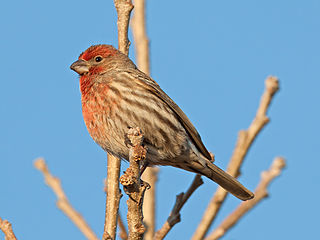
The house finch is a bird in the finch family Fringillidae. It is native to western North America, and has been introduced to the eastern half of the continent and Hawaii. This species and the other "American rosefinches" are placed in the genus Haemorhous.
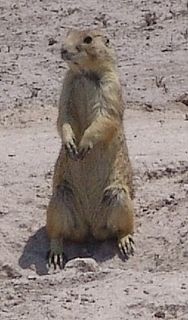
The Mexican prairie dog is a diurnal burrowing rodent native to Mexico. Treatment as an agricultural pest has led to its status as an endangered species. They are closely related to squirrels, chipmunks, and marmots. Cynomys mexicanus originated about 230,000 years ago from a peripherally isolated population of the more widespread Cynomys ludovicianus.

The great-tailed grackle or Mexican grackle is a medium-sized, highly social passerine bird native to North and South America. A member of the family Icteridae, it is one of ten extant species of grackle and is closely related to the boat-tailed grackle and the slender-billed grackle. It is sometimes erroneously referred to as a "blackbird" in the southern United States, although blackbirds belong to other genera such as Euphagus. Similarly, it is often called cuervo in areas of Mexico owing to its glossy black plumage, although it is not a member of the genus Corvus, nor even of the family Corvidae.
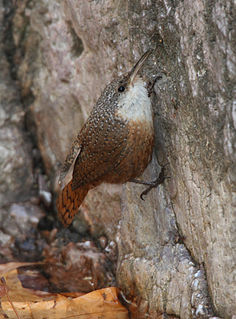
The canyon wren is a small North American songbird of the wren family Troglodytidae. It is resident throughout its range and is generally found in arid, rocky cliffs, outcrops, and canyons. It is a small bird that is hard to see on its rocky habitat; however, it can be heard throughout the canyons by its distinctive, loud song. It is currently in a monotypic taxon and is the only species in the genus Catherpes.

The Mexican hornshark is a bullhead shark of the family Heterodontidae. This shark is grey-brown in color, with black spots scattered on the fins and body. It has a cylindrical trunk, conical head, and small spiracles behind the eyes. The snout of the Mexican hornshark is very round and blunt. Like all members of the order Heterodontiformes, this shark has fin spines in front of both of its dorsal fins. The first dorsal fin originates before the pectoral fins, while the second dorsal fin originates behind the pelvic fins. The Mexican hornshark reaches a maximum length around 70 cm, but usually reaches between 50 and 60 cm on average. Young hornsharks hatch around 14 cm.

The Mexican big-eared bat is a species of vesper bat endemic to Mexico. They are nocturnal and insectivorous. Their very large ears are located across their foreheads, and when captured, the bats are observed to curl their ears in a protective manner. The adults are usually brown colored, while the juveniles are usually a smokey brown color. They have small noses.
The Mexican vole is a species of rodent in the family Cricetidae found in Mexico and the United States.
The Mexican deer mouse is a species of forest-dwelling rodent in the family Cricetidae. It is found in southern Mexico and throughout much of Central America.
The Mexican harvest mouse is a species of rodent in the family Cricetidae. It is found in Colombia, Costa Rica, Ecuador, El Salvador, Guatemala, Honduras, Mexico, Nicaragua, and Panama in a variety of habitats at altitudes from sea level to 3800 m.
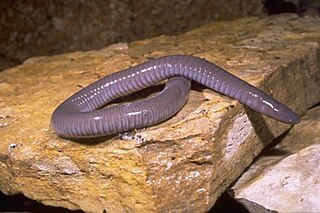
Dermophis mexicanus, the Mexican burrowing caecilian, is a species of limbless amphibian in the family Dermophiidae. It is found in Mexico and Central America, where it burrows under leaf litter and plant debris.
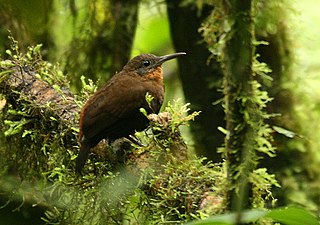
The tawny-throated leaftosser is a tropical American bird species in the ovenbird family Furnariidae. It is also known as the tawny-throated leafscraper, Mexican leaftosser or Mexican leafscraper. This bird might be a cryptic species complex.
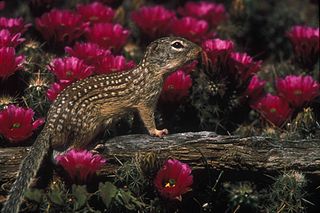
The Mexican ground squirrel is a species of rodent in the family Sciuridae. It is found in Mexico and the United States. One of its closest relatives is the thirteen-lined ground squirrel.

The Mexican dog-faced bat is a bat species of the family Molossidae from Central America. It is found from Nayarit in Mexico to Costa Rica at elevations up to 1500 m. It was formerly considered a subspecies of C. greenhalli. It roosts in deciduous and evergreen forest, and is usually found near small bodies of water.

The black-necked stilt is a locally abundant shorebird of American wetlands and coastlines. It is found from the coastal areas of California through much of the interior western United States and along the Gulf of Mexico as far east as Florida, then south through Central America and the Caribbean to Ecuador and the Galápagos Islands. The northernmost populations, particularly those from inland, are migratory, wintering from the extreme south of the United States to southern Mexico, rarely as far south as Costa Rica; on the Baja California peninsula it is only found regularly in winter.
Colobotheini is a tribe of longhorn beetles of the Lamiinae subfamily.
Apechthes is a genus of longhorn beetles of the subfamily Lamiinae.
Apechtes championi is a species of beetle in the family Cerambycidae. It was described by Bates in 1881. It is known from Guatemala and Honduras.
















